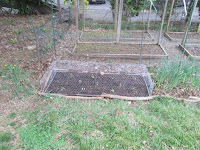The Gardeners' Holiday that falls at the start of May is always a bit of a catch-as-catch-can. For the first few years, it was a celebration of our asparagus harvest, but lately the asparagus hasn't been reliable enough for us to count on having enough of it for a meal by this point. So instead, I've used this holiday to mark various other gardening activities, such as putting in our spring crops, our honeyberry bushes, and our new flowerbed.
This year's May Gardeners' Holiday is a little different. It's not about anything we planted; it's about something we harvested without planting it. Specifically, dandelions.
Most people think of the dandelion as just a useless weed, but it's also a vegetable. In fact, just about every part of it is edible. You can boil the roots or roast and grind them to brew into tea. You can batter-fry the blossoms or brew them into wine. And you can use the nutritious greens in a wide variety of ways: steamed, boiled, sauteed, raw in a salad, ground in a pesto, or blended in a smoothie.
So, when Brian pulled out a whole mess of dandelions while weeding the garden beds, he decided he might as well put them to good use. Rather than just toss them in the compost, he brought them in, washed them, wrapped them in a clean dishtowel, and stashed them in the fridge. (Side note: this is the best way we've found for keeping lettuce or any kind of greens fresh. Clean them thoroughly, soak them in water to plump them up, then wrap them in a cloth towel and store them in a zip-top bag. The towel absorbs excess moisture, so the greens don't rot as quickly. Most sources say to use paper towels for this, but we find a cloth one works just as well.)Then, of course, he had to figure out what to do with them. For years, our go-to method of cooking dandelion greens was one we pulled out of a cookbook called Mountain Cookin': wilt them slightly in a hot skillet, then toss them with a dressing of hot bacon grease, vinegar, and a touch of sugar and salt. This combination of flavors (salty, sour, umami, and a little bit sweet) balances out the bitterness of the greens and makes them quite palatable. But now that we've almost entirely given up meat, this method was no longer an option. Of course, we could have used a plain vinegar dressing without the bacon, but we strongly suspected they wouldn't taste nearly as good this way.
So instead, Brian experimented with several different methods of concealing the greens in different dishes, the same way he's learned to do with eggplant. First he tried chopping some up and adding them to a batch of savory corn cakes, a recipe from Mollie Katzen's Vegetable Heaven that he's tinkered with considerably over the years. He'd done this before with frozen spinach and found that the greens more or less melted into the background, and it worked pretty much the same way with the dandelion greens.
Next, he tried stirring some into a batch of chili. This was also reasonably successful. The texture of the greens stood out a little more, but their bitter flavor wasn't really noticeable with all the other flavors in Brian's chili. With onion, green pepper, tomato, eggplant, red kidney beans, black beans, garlic powder, nutritional yeast, a touch of lime, and a whopping three tablespoons of chili powder all vying for attention, the greens were barely detectable.
His third attempt, however, was not a success. Since we had baby bella mushrooms and leeks in the fridge, he improvised a mushroom-leek soup that would probably have been quite tasty on its own, with nutritional yeast, bay leaf, and thyme to boost the flavor and silken tofu to give it a heartier texture. But then he decided to throw in some of the dandelion greens as well, and that turned out to be a mistake. The flavors in this soup were milder and more subtle than those in the other two recipes, and the bitterness of the dandelion greens became the dominant note. Brian didn't mind it as much as I did, but neither of us really enjoyed it.
Based on this experience, I'd say the secret to eating dandelion greens is to combine them with other flavors that can stand up to them and not get pushed around. If you just pick a leaf off a dandelion and chew it up, you will find it bitter and somewhat tough, and you most likely will not enjoy the experience. But in a recipe with lots of other strong-tasting ingredients, that same bitter green becomes at least unobtrusive and, at best, even pleasant. In cooking as in life, a touch of bitterness adds a welcome complexity to the flavor, but too much of it spoils the entire dish.










